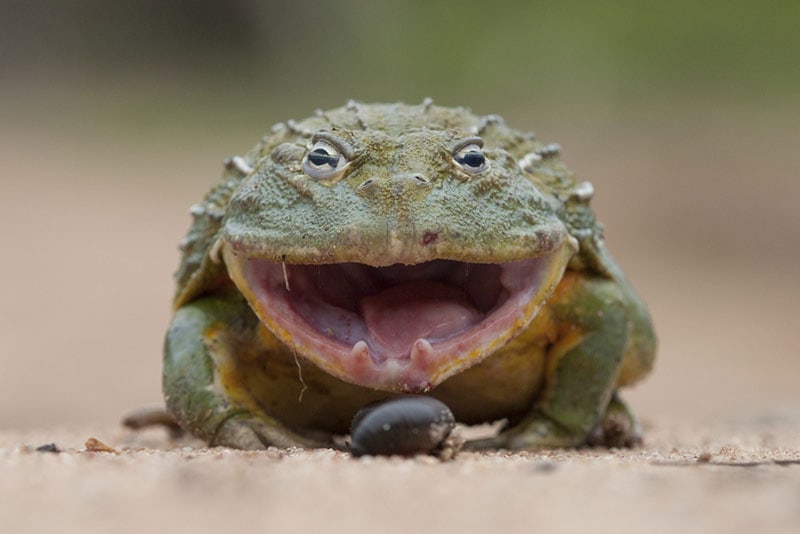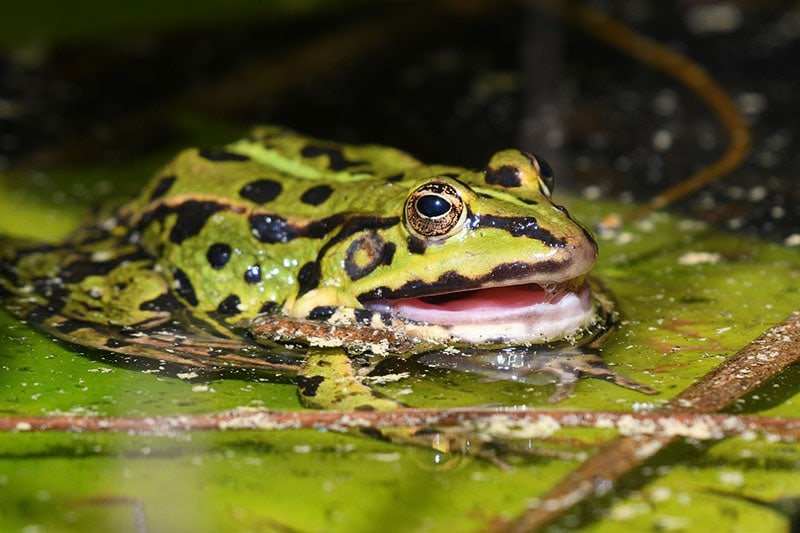Do Frogs Have Teeth? Fascinating Facts & FAQs
Updated on

Frogs are one of nature’s strangest, quirkiest residents, and their teeth are just as weird. Yes, frogs do have teeth – a feature which helps distinguish some of them from toads. Their teeth evolved much differently from other creatures’ chompers, and they use them in very different ways too!
A few frogs lack teeth altogether, using a super-sticky tongue to catch food. Most common species only have small nubs for teeth in their mouths, whose sole purpose is to help grip prey before they swallow it. Lastly, more carnivorous frogs have larger, fang-like teeth used to grab prey or even inject them with venom, in the case of the deadly poison dart frog.
If you’re interested in learning more about how frog teeth work, you’re in the right place. Below, we’ll be covering everything you could ever want to know about frog teeth, including why not all frogs have teeth, how frog teeth evolved, and more.
All About Frog Teeth
Please note that many states and jurisdictions may have legislation that prevents capturing or owning frogs. Always make sure you have the permission to legally own an exotic pet before deciding to adopt one. Capturing wild animals is not advised, as this disrupts local ecosystems. In addition, amphibians may naturally harbor Salmonella and spread it to humans and other pets. These pets are not recommended to be kept alongside children, the elderly, pregnant individuals, or those with a compromised immune system. Hygiene is of utmost importance when dealing with amphibians.
If you are in the US, please refer to state laws before deciding to adopt an exotic or wild pet. Elsewhere, please refer to relevant jurisdictions in your area.
Frog teeth are minuscule compared to ours, measuring only up to 1 millimeter in length. Unlike most mammals, including humans, frog teeth only have one shape. That’s because these small cone-shaped nubs are primarily to grip and hold prey while the frog swallows it whole, rather than chewing it like us.
There are two main types of frog teeth: maxillary and vomerine. Maxillary teeth are the tiny nubs on the top of their mouth, which are nearly impossible to see unless you’re looking very closely. The vomerine teeth are even smaller, usually clustered together in pairs on the roof of a frog’s teeth
Interestingly, frogs lose their teeth similarly to how snakes shed their skin. From time to time, a frog will lose their teeth and grow them back completely anew. As far as we can tell, a frog will continuously go through this tooth-regrowing process until they die.
Most species of frogs with teeth lack true teeth, which refers to teeth which contain all three parts of a tooth – the outermost enamel, the dentine, and innermost pulp.
Of the 7,000 or so frog species, only one (Gastrotheca guentheri) has true teeth on both upper and lower jaws. Interestingly, their teeth re-evolved after a period of absence which lasted about 200 million years!

Do Frogs Bite?
Most frogs do not bite, whether it’s hunting prey or acting in self defense. Only a few large, aggressive frogs will bite and have teeth that can actually hurt a person—the African Bullfrog is known to bite, for instance. Some species of poison dart frogs in South America have fang-like teeth, but others only have a sticky tongue.
Frog teeth, as mentioned above, are only for helping the frog grip and crush their prey. They usually use their sticky tongue to grab a bug and rapidly retract it, swallowing it whole. That’s usually enough for most frogs, who rarely use their teeth, but not all. Larger frogs have slightly bigger teeth that are more important, used to help the frog swallow salamanders, small mammals, and similarly sized prey.
Why Do Some Frogs Have Teeth While Others Don’t?
Smaller frogs that subsist on plants or small bugs simply didn’t need teeth to effectively hunt, so they never developed teeth over time. Think about it: if you mostly eat flies and algae, why would you need teeth? In other carnivorous species that eat larger prey, the teeth were necessary to grip prey to get it swallowed. Lastly, some poisonous frogs use snake-like fangs to inject prey with toxic venom as a self-defense mechanism.
From a scientific standpoint, frogs that lack teeth had modifications to the major tooth enamel gene amelogenin, which led to an evolutionary pathway devoid of teeth.

Final Thoughts
Frogs are fascinating creatures, repellant to some people and adored by others. Either way, it’s really interesting to find out that frogs have teeth. They’re tiny, regenerate over time, and some species use them differently than others to hunt.
You Might Also Be Interested In:
Featured Image Credit: Stu Porter, Shutterstock









